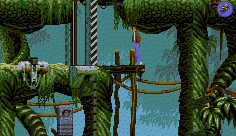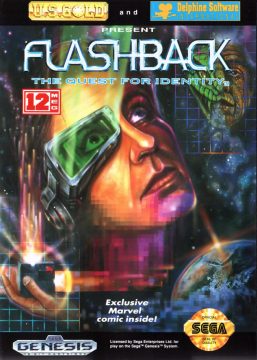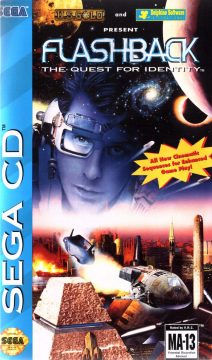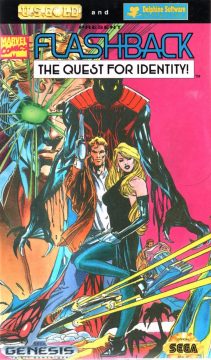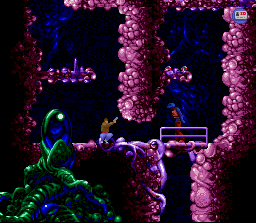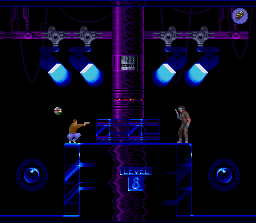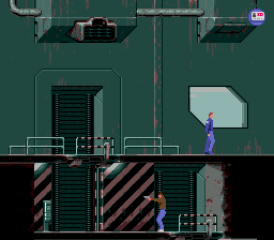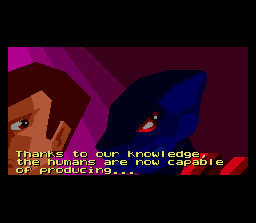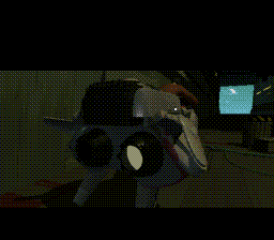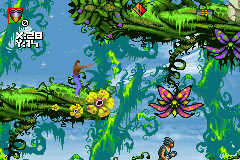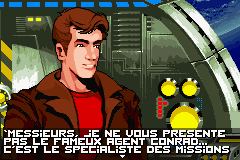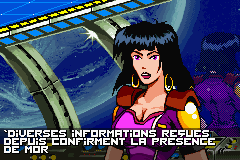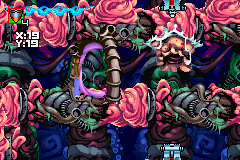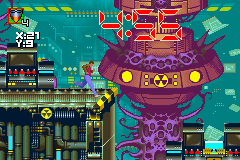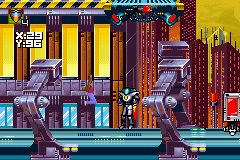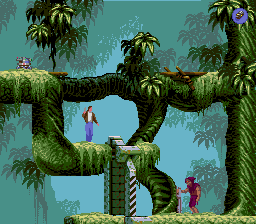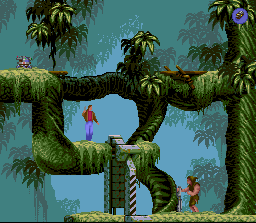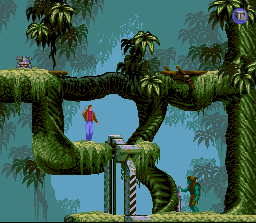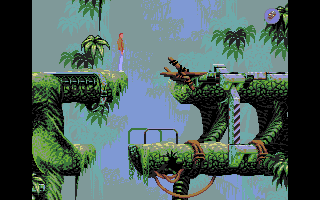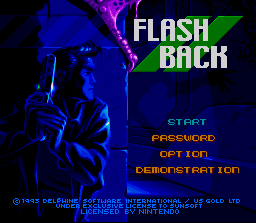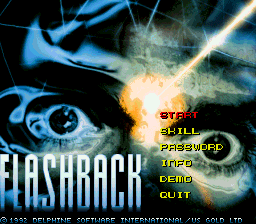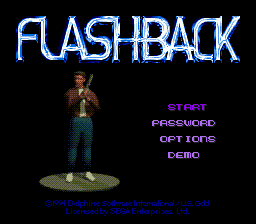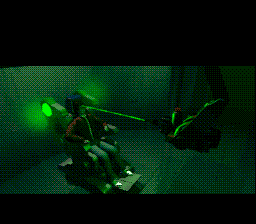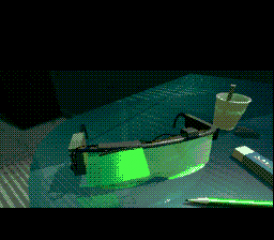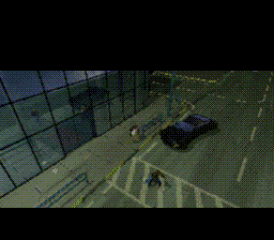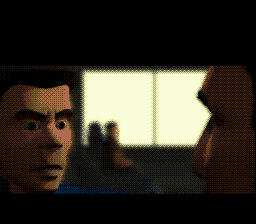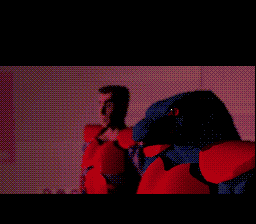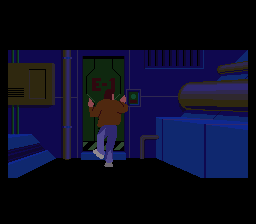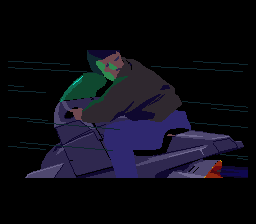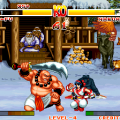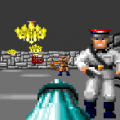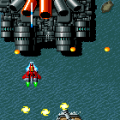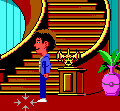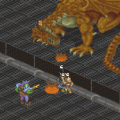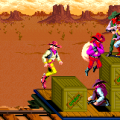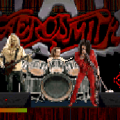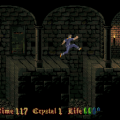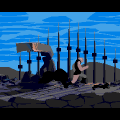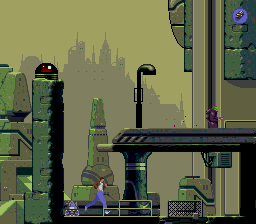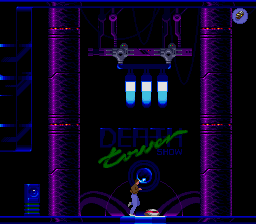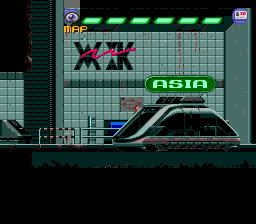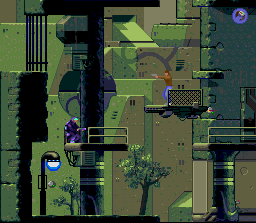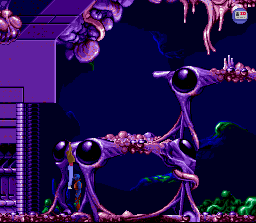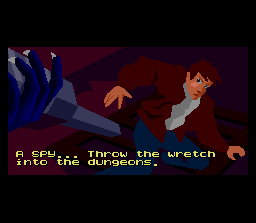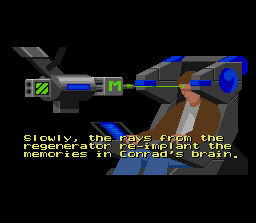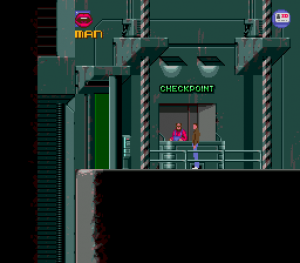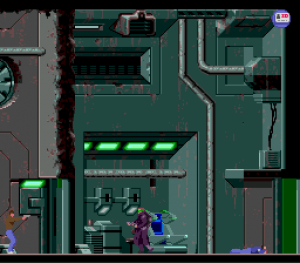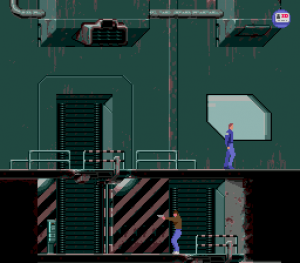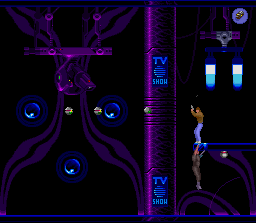- Flashback: The Quest for Identity
The advent of the CD-ROM meant that developers could finally tell realistic stories with their games with real actors, real scripts and real full motion video. The massive problem was the stories usually were usually terrible, the production values laughable, and the actual game to be almost nonexistent. Around this time, the French software company Delphine launched Flashback: The Quest for Identity onto the world. At a time when having a CD-ROM (either on a computer or a console) was a luxury, it advertised itself as “the CD-ROM game on a cartridge.” Delphine not only crafted an excellent work of science fiction, filled with fully animated cutscenes, but also wrapped it around an amazingly cool game. It shares the look and feel of Delphine’s previous game, Out of this World (which used similar techniques), although the games are pretty unrelated otherwise.
On the surface, Flashback doesn’t seem much more than a Prince of Persia clone. Sure, you climb platforms, perform running jumps, hit switches, solve little puzzles to proceed – the usual stuff. Conrad actually controls quite a bit better than the old Prince ever did – pressing left or right makes Conrad walk in that direction (as opposed to running). If you need to jump on a higher ledge, you can just run towards it and he will automatically leap up to it. Such little tweaks to the old formula make Flashback much smoother than the game that inspired it.
As opposed to sword fighting, you’ll spend a lot of time blasting bad guys with your gun, which luckily has unlimited bullets. While some enemies can be killed by simply blasting away (or being quick on the draw), you’ll need to define strategies to kill certain baddies. Early in the game, you get a bullet shield which will protect you from all projectiles for about a second. The key to winning many gunfights is using this shield at the right time to protect yourself then shoot the enemy when they’re off guard. Thankfully, you can take four hits before perishing, unless you do something stupid like running into flames or standing still on electric floors. Of course, you WILL die, although you’ll find plenty of save stations that act as checkpoints.
The highly touted cinemas are almost entirely created with polygonal vector graphics, although the level of detail varies greatly. Every time you pick up an item, recharge your shield, or exchange money you’re treated to a tiny scene. In between levels, though, they unravel a plot that pays homage to several great science fiction films. The game begins as Conrad is running away from someone, presumably bad, who is shooting at him. He escapes on a hoverbike, only to be shot down. Awakening in the jungle, Conrad realizes he has no idea what’s going on – the only clue Conrad has is a holocube video of himself saying to visit his friend in a city known as New Washington.
Luckily, New Washington is the second level, as it is beneath the crest of the planet Conrad is currently on. If you’re too impatient, you can just read the plot in the Marvel comic that’s included with the manual, although it only details the prologue. (It proclaims to be “continued” in the official strategy guide, though this only offers a few more pages and certainly not the complete story.) Conrad is actually a hotshot government agent, working on a pair of goggles that can “analyze molecular density”. For all practical purposes, this lets him see that some humans are actually aliens in disguise who are attempting to gain control of the Earth government for undoubtedly nefarious reasons (a la “They Live”, the classic movie with Rowdy Roddy Piper as the hero.) Of course, Conrad is kidnapped and brainwashed, but manages to escape, which is where the game begins.
After deciphering what happened, Conrad swears to do everything he can to destroy the bad guys, dubbed “Morphs”. This includes becoming a detective/bounty hunter to earn pocket change, participating in a survival game show called Deadly Tower, getting chased down by the Earth police force, and eventually transporting to the Morph’s home planet. There are only seven levels in total, of wildly varying lengths. Unfortunately, you can’t actually save your game – there are only passwords that let you skip between stages. This gets to be a particular pain in the second level, which is by far the longest in the game. Still, other than the occasionally wonky controls, those are really the only complaints that can be lodged against this classic.
The Amiga, Genesis and PC disk versions were the first to the hit the market. While the Genesis version has slightly inferior graphics due to the limited color palette, it still manages to look quite good – the only real noticeable difference is in the detail of the sprites. Oddly enough, Conrad wears a white shirt in the Genesis version, and a rather bizarre magenta one in all of the other versions. The Genesis (and all of the other cartridge versions) also have annoying second-long load times between screens.
The PC version switches screens instantly, and benefits from nicer graphics and smoother, extended cutscenes (most noticeable in the intro and trip to Earth.) It also has a weird option that zooms in on the action whenever Conrad kills anybody. It’s meant to be cinematic but it’s unnecessarily jarring and the characters are extremely pixellated anyway. The SNES version followed, which looks as nice as the PC version but runs the cutscenes a little bit slower than the Genesis version and also changes the name of the game show “Death Tower” into “Cyber Tower”. The Jaguar version is the smoothest and probably the best of the cartridge releases, though not by a wide margin.
After bragging about that whole “CD game on a cartridge” bit, it’s kind of a sellout that Flashback was actually released on CD, several times. The PC and 3DO releases are pretty much the same, adding in CG rendered cutscenes in place of the old polygonal ones. While the developers probably thought this was an enhancement, it really isn’t – these cinemas are poorly modeled by today’s standards and a lot of the “gee whiz” factor of the original game is lost entirely. Plus, accessing the cutscenes adds some unneeded load time, especially when you’re just doing something simple, like picking up an item.
Flashback was even released for the “multimedia entertainment system” Phillips CD-i, where it suffers from some annoying bars on the side of the screen. The Sega CD release also contained the pre-rendered cutscenes, and they look even worse due to the crappy color palette. To make up for it, the Sega CD version contains full voices to all of the characters (as opposed to the other versions, which just have them in the cinema sequences) as well as a constantly running CD soundtrack. From the remixed version of the creepy title theme, to the tribal drums of the jungle music, the music really adds plenty of atmosphere to what had previously been a mostly silent game.
While Flashback was released by US Gold in North America and Europe, it was distributed by Sunsoft in Japan. For some reason, the flesh colors of all of the enemies were changed to make them look less human – many of them now have green skin. Why this was done is uncertain – whether it be an artistic choice or some kind of weird censorship. There is a Japanese PC-98 version, with heavily dithered graphics, but at a higher resolution, whereas the FM-Towns version looks just like its Western counterparts. The Macintosh port also runs in higher resolution, but the filter that’s applied to the graphics makes the game look a bit cheap.
Flashback Legends – Game Boy Advance (unreleased)
Flashback Legends was to be a remake for the Game Boy Advance, developed by Adeline Software, a subsidiary of Delphine. Although it was never officially announced, the word is that it was under development in 2004. A prototype ROM was leaked onto the Internet in 2008, showing the game in alpha state. From the looks of it, it seems that the plot was to be slightly different, although the basic elements – the jungle, New Delphi City, the alien planet and the morphs – were still present. All of the FMV-style movies are gone, replaced with static comic book-style artwork.
Although the ROM offers several language choices, only French is actually available. The game ditches the single screens in favor of a huge single scrolling map, but the beta levels all consist of very simple key and lock hunts – it’s all very simplistic and straightforward. The level designs themselves are totally different from the original. Who knows if they intended to create more advanced stages.
Although Conrad’s sprite is carried forward (probably a placeholder), the rest of the assets are all brand new, with the background graphics actually looking pretty damn good. Obviously, being in an alpha state, there are tons of issues with it. The engine is slow and choppy, filled with flickering and slowdown. There are technically sixteen levels, but most of them are incomplete, and many are technically unbeatable, due to items being out of reach. It’s also incredibly tough, as the enemies take several shots, and are positioned in fairly great numbers.
The only way to progress is through the built-in cheat code – pause the game, highlight the “Help” option, then hold L, R, Select and Start to skip to the next stage. You can also enter the cheat code 0201F204:04 in an emulator for unlimited shields. (Thanks to ReyVGM for the code.)
Screenshot Comparisons
